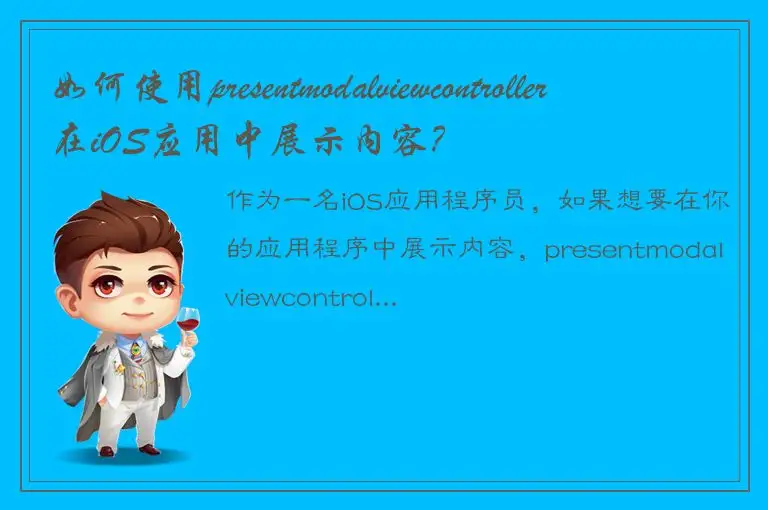作为一名iOS应用程序员,如果想要在你的应用程序中展示内容,presentmodalviewcontroller这个功能非常重要。

在iOS开发中,presentmodalviewcontroller被广泛用于展示内容,包括弹出窗口、登录、注册、忘记密码页面、警告框,以及更多的页面。
它的使用非常简单,只需要向视图控制器添加一个modalviewcontroller即可。但是,这个功能有很多需要考虑的细节。在本文中,我们将介绍如何使用presentmodalviewcontroller在iOS应用程序中展示内容。
1. 创建基本视图
首先,我们需要创建一个基本视图来展示内容,这可以通过编写一个新的视图控制器或使用现有的视图控制器来完成。
如果你打算使用一个新的视图控制器,你需要创建一个新的Subclass of UIViewController,并将它的视图添加到控制器的View属性中。如果你想使用现有的视图控制器,你可以直接跳过这一步。
2. 设置弹出窗口
现在,我们需要设置presentmodalviewcontroller作为一个弹出窗口,在这个窗口中展示内容。我们需要使用一个模态视图控制器来实现这一步骤。首先,我们需要创建一个新的视图控制器,然后在它的视图控制器中添加一个presentmodalviewcontroller。你可以通过以下几步来实现:
* 在视图控制器的头文件中声明一个新的变量:
@property (strong, nonatomic) UIViewController *modalViewController;
* 在视图控制器的实现文件中,添加一个方法来创建和展示modalviewcontroller:
- (void)presentModalViewController {
UIViewController *modalViewController = [[UIViewController alloc] init];
[self presentViewController:self.modalViewController animated:YES completion:nil];
}
3. 自定义弹出窗口
现在,我们已经成功创建了一个弹出窗口,但是我们需要向其中的内容添加一些定制,以使其更好地适应我们的应用程序。
我们可以通过以下几个步骤来实现这一点:
* 在modalviewcontroller视图控制器中添加一个UILabel,作为标题;
* 添加一个UITextView,用于展示内容;
* 添加一个UIButton,用户在查看完内容后可以关闭窗口;
* 根据需要添加一些自定义的样式。
代码示例:
- (void)presentModalViewController {
UIViewController *modalViewController = [[UIViewController alloc] init];
UILabel *titleLabel = [[UILabel alloc] initWithFrame:CGRectMake(0, 0, modalViewController.view.frame.size.width, 44)];
titleLabel.text = @"弹出窗口";
titleLabel.textAlignment = NSTextAlignmentCenter;
[modalViewController.view addSubview:titleLabel];
UITextView *textView = [[UITextView alloc] initWithFrame:CGRectMake(0, 44, modalViewController.view.frame.size.width, 100)];
textView.text = @"这里将展示内容";
[modalViewController.view addSubview:textView];
UIButton *cancelButton = [[UIButton alloc] initWithFrame:CGRectMake(modalViewController.view.frame.size.width - 50, 0, 50, 44)];
[cancelButton setTitle:@"关闭" forState:UIControlStateNormal];
[cancelButton setTitleColor:[UIColor blueColor] forState:UIControlStateNormal];
[cancelButton addTarget:self action:@selector(dismissModalViewController) forControlEvents:UIControlEventTouchUpInside];
[modalViewController.view addSubview:cancelButton];
modalViewController.modalPresentationStyle = UIModalPresentationOverCurrentContext;
[self presentViewController:modalViewController animated:YES completion:nil];
}
4. 关闭弹出窗口
最后,当用户完成查看并关闭弹出窗口时,我们需要关闭modalviewcontroller。为了实现这一点,我们需要添加一个closeButton,并为其添加dismissModalViewController方法:
- (void)dismissModalViewController {
[self.modalViewController dismissViewControllerAnimated:YES completion:nil];
}
现在,我们已经了解了如何使用presentmodalviewcontroller在iOS应用程序中展示内容。在实现这个功能时,请记住以下几点:
* 需要将modalviewcontroller作为弹出窗口,在其中展示内容;
* 可以自定义弹出窗口的外观与内容;
* 当用户完成查看弹出窗口中的内容时,需要添加一种关闭方式。
希望这篇文章能够帮助你理解如何在iOS应用程序中使用presentmodalviewcontroller展示内容。祝你在开发过程中,一切顺利!




 QQ客服专员
QQ客服专员 电话客服专员
电话客服专员